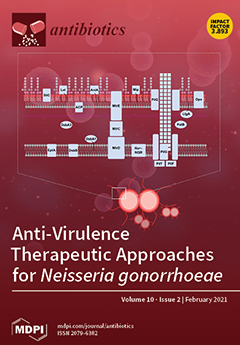The community-associated methicillin-resistant
Staphylococcus aureus (CA-MRSA) has become increasingly prevalent in both community and hospital settings. The aim of this study was to determine the prevalence, molecular characteristics and antibiotic resistance profiles of CA-MRSA from community- and hospital-associated infections in a tertiary care
[...] Read more.
The community-associated methicillin-resistant
Staphylococcus aureus (CA-MRSA) has become increasingly prevalent in both community and hospital settings. The aim of this study was to determine the prevalence, molecular characteristics and antibiotic resistance profiles of CA-MRSA from community- and hospital-associated infections in a tertiary care hospital in Mangalore, India. Of 520
S. aureus isolates, 362 were from inpatients (IP) and 158 were from outpatients (OP). One-hundred and thirty-two MRSA isolates obtained from 94 inpatients and 38 outpatients with complete clinical details were further analyzed. Of these, 81 (61.4%) were CA-MRSA (IP-47.9%, OP-94.7%) and 51 (38.6%) were HA-MRSA (IP-52.1%, OP-5.3%). All (100%) MRSA isolates were
mecA gene positive. SCC
mec typing identified SCC
mec type IV (50.6%) and SCC
mec type V (66.7%) in CA-MRSA, while SCC
mec type I (41.2%), SCC
mec type III (19.6%), SCC
mec type IV (31.4%) and SCC
mec type V (25.5%) were detected in HA-MRSA isolates. The Panton–Valentine Leukocidin (PVL) gene was found in 70.4% of CA-MRSA, 43.1% of HA-MRSA with SCC
mec type IV and SCC
mec type V, and in 7.8% of true HA-MRSA. The antibiotic resistance profiles were determined by the disc diffusion method. Resistance to cefoxitin was used to identify MRSA. A significant difference
(p < 0.05) was observed between CA-MRSA and HA-MRSA with respect to resistance against cephalexin, cefotaxime, levofloxacin, linezolid and teicoplanin. CA-MRSA was predominantly resistant to ciprofloxacin (86.4%), erythromycin (66.7%), ofloxacin (49.4%), cefotaxime (44.4%), gentamicin (40.7%) and clindamycin (40.7%), while HA-MRSA showed resistance against ciprofloxacin (80.4%), erythromycin (80.1%), cefotaxime (70.6%),ofloxacin (58.8%), clindamycin (47.1%) and levofloxacin (41.2%).This study reports the prevalence of CA-MRSA in community and hospital settings and the possibility of multidrug-resistant CA-MRSA replacing HA-MRSA in hospitals. The observations from our study emphasize the need for urgent measures to manage this emerging crisis in healthcare settings.
Full article






